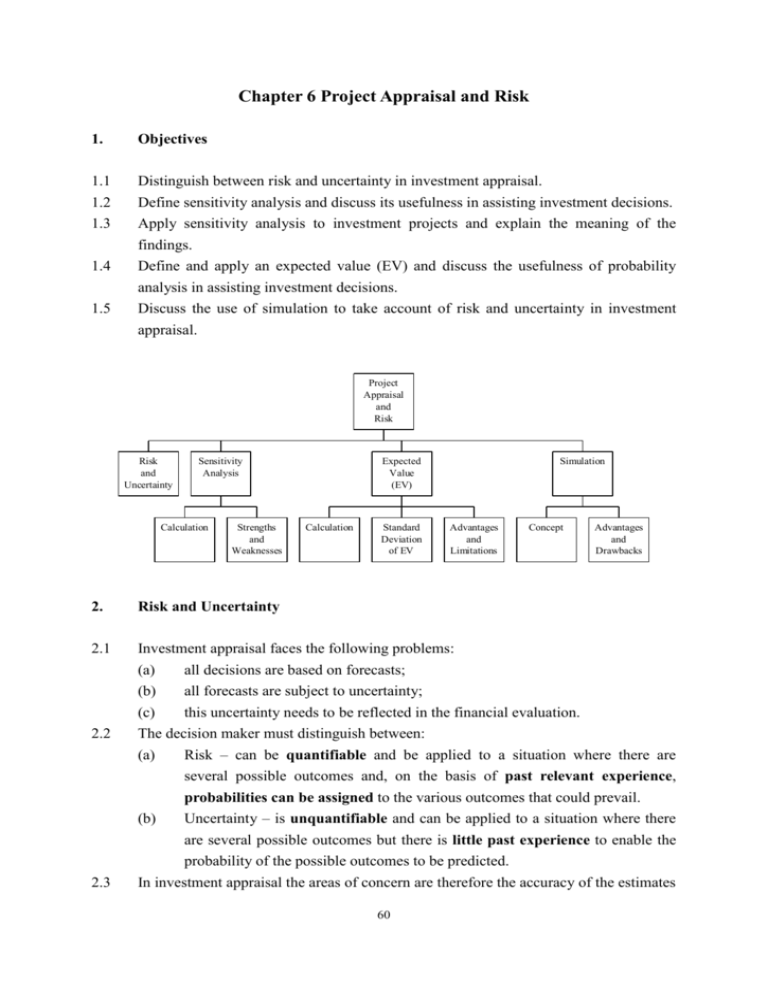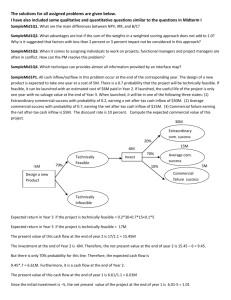Chapter 6 Project Appraisal and Risk
advertisement

Chapter 6 Project Appraisal and Risk 1. Objectives 1.1 1.2 1.3 Distinguish between risk and uncertainty in investment appraisal. Define sensitivity analysis and discuss its usefulness in assisting investment decisions. Apply sensitivity analysis to investment projects and explain the meaning of the findings. Define and apply an expected value (EV) and discuss the usefulness of probability analysis in assisting investment decisions. Discuss the use of simulation to take account of risk and uncertainty in investment 1.4 1.5 appraisal. Project Appraisal and Risk Risk and Uncertainty Sensitivity Analysis Calculation Strengths and Weaknesses Expected Value (EV) Calculation Standard Deviation of EV Simulation Advantages and Limitations Concept 2. Risk and Uncertainty 2.1 Investment appraisal faces the following problems: (a) all decisions are based on forecasts; (b) all forecasts are subject to uncertainty; (c) this uncertainty needs to be reflected in the financial evaluation. 2.2 The decision maker must distinguish between: Risk – can be quantifiable and be applied to a situation where there are several possible outcomes and, on the basis of past relevant experience, probabilities can be assigned to the various outcomes that could prevail. (b) Uncertainty – is unquantifiable and can be applied to a situation where there are several possible outcomes but there is little past experience to enable the probability of the possible outcomes to be predicted. In investment appraisal the areas of concern are therefore the accuracy of the estimates (a) 2.3 Advantages and Drawbacks 60 concerning: (a) (b) (c) Project life Predicted cash flows and associated probabilities Discount rate used 3. Sensitivity Analysis 3.1 Sensitivity analysis typically involves posing “what if?” questions. For example, what if demand fell by 10% compared to our original forecasts? Would the project still be viable? 3.2 In project appraisal, sensitivity analysis assesses how responsive the project’s NPV 3.3 is to changes in the variables used to calculate that NPV. The NPV could depend on a number of uncertain independent variables. (a) Selling price 3.4 3.5 (b) Sales volume (c) Cost of capital (d) Initial cost (e) Operating costs (f) Benefits Sensitivity analysis therefore provides an indication of why a project might fail. Management should review critical variables to assess whether or not there is a strong possibility of events occurring which will lead to a negative NPV. Management should also pay particular attention to controlling those variables to which the NPV is particularly sensitive, once the decision has been taken to accept the investment. A simple approach to deciding which variables the NPV is particularly sensitive to is to calculate the sensitivity of each variable: Sensitivity 3.6 = NPV PV of project variable % The lower the percentage, the more sensitive is NPV to that project variable as the variable would need to change by a smaller amount to make the project non-viable. 61 3.7 EXAMPLE 1 ABC Co is considering a project with the following cash flows. Year Initial Variable costs Cash inflows Net cash flows investment ($000) ($000) ($000) 1 (2,000) 6,500 4,500 2 (2,000) 6,500 4,500 ($000) 0 7,000 Cash flows arise from selling 650,000 units at $10 per unit. ABC Co has a cost of capital of 8%. Required: Measure the sensitivity of the project to changes in variables. Solution: The PVs of the cash flow are as follows. Year Discount PV of initial PV of PV of cash PV of net factor 8% investment variable costs inflows cash flow $000 $000 $000 $000 0 1.000 (7,000) (7,000) 1 0.926 (1,852) 6,019 4,167 2 0.857 (1,714) 5,571 3,857 (3,566) 11,590 1,024 (7,000) NPV = 1,024 The project has a positive NPV and would appear to be worthwhile. The sensitivity of each project variable is as follows. (a) Initial investment Sensitivity = 1,024 / 7,000 x 100% = 14.6% (b) Sales volume Sensitivity = 1,024 / (11,590 – 3,566) x 100% = 12.8% 62 (c) Selling price Sensitivity = 1,024 / 11,590 x 100% = 8.8% (d) Variable costs Sensitivity = 1,024 / 3,566 x 100% = 28.7% (e) Cost of capital. We need to calculate the IRR of the project. Year Net cash Discount flow factor 15% PV Discount PV factor 20% $000 $000 $000 0 (7,000) 1 (7,000) 1 (7,000) 1 4,500 0.870 3,915 0.833 3,749 2 4,500 0.756 3,402 0.694 3,123 317 (128) 317 (0.2 0.15) = 18.56% IRR = 0.15 + 317 128 The cost of capital can therefore increase by 133% before the NPV becomes negative. The elements to which the NPV appears to be most sensitive are the selling price followed by the sales volume. Management should thus pay particular attention to these factors so that they can be carefully monitored. 3.8 Strengths and weaknesses of sensitivity analysis Strengths (a) (b) (c) No complicated Weaknesses theory to (a) understand. Information will be presented to management in a form which facilitates subjective judgement to decide the likelihood of the various possible outcomes considered. Identifies areas which are crucial 63 It assumes that changes to variables can be made independently, e.g. material prices will change independently of other variables. This is unlikely. If material prices went up the firm would probably increase selling price at the same time and there would be little effect on NPV. A (d) to the success of the project. If the technique called simulation (see project is chosen, those areas can be carefully monitored. Indicates just how critical are (b) some of the forecasts which are considered to be uncertain. later) allows us to change more than one variable at a time. It only identifies how far a variable needs to change. It does not look at the probability of such a change. In the above analysis, sales volume appears to be the most crucial variable, but if the firm were facing volatile raw material markets a 65% change in raw material prices would be far more likely than a 29% change in sales volume. (c) It is not an optimising technique. It provides information on the basis of which decisions can be made. It does not point directly to the correct decision. 4. Expected Value (EV) 4.1 When there are a number of possible outcomes for a decision and probabilities can be assigned to each, then an EV may be calculated. 4.2 CONCEPT The EV is the weighted average of all possible outcomes, with the weightings based on the probability estimates. The formula for calculating an EV is: EV = px Where: p = the probability of an outcome x = the value of an outcome 64 4.3 EXAMPLE 2 A firm has to choose between three mutually exclusive, the outcomes of which depend on the state of the economy. The following estimates have been made: State of the economy Probability Project A Project B Project C Recession Stable Growing 0.5 NPV ($000) 100 0 180 0.4 NPV ($000) 200 500 190 0.1 NPV ($000) 1,400 600 200 Determine which project should be selected on the basis of expected market values. Solution: Project A State of the economy Recession Stable Growing Probability Project NPV $000 EV $000 0.5 0.4 0.1 100 200 1,400 50 80 140 270 Project B State of the economy Probability Recession Stable 0.5 0.4 Project NPV $000 0 500 Growing 0.1 600 EV $000 0 200 60 260 Project C State of the economy Recession Stable Probability 0.5 0.4 65 Project NPV $000 180 190 EV $000 90 76 Growing 0.1 200 20 186 On the basis of expected values, Project A should be selected. However, it should be noted that Project A is also the most risky option as it has the widest range of potential outcomes. 4.4 EXAMPLE 3 ABC Co is considering an investment of $460,000 in a non-current asset expected to generate substantial cash inflows over the next five years. Unfortunately the annual cash flows from this investment are uncertain, but the following probability distribution has been established: Annual cash flow ($) 50,000 100,000 150,000 Probability 0.3 0.5 0.2 At the end of its five-year life, the asset is expected to sell for $40,000. The cost of capital is 5%. Should the investment be undertaken? Solution: Expected annual cash flows are: Annual cash flow 50,000 100,000 150,000 Probability 0.3 0.5 0.2 EV 15,000 50,000 30,000 95,000 NPV calculation: Time 0 1 2 Cash flow (460,000) 95,000 40,000 DF 5% 1.000 4.329 0.784 NPV = 66 PV (460,000) 411,255 31,360 (17,385) As the ENPV is negative, the project should not be undertaken. An alternative approach would be to calculate three separate NPVs and then combine them, giving the following figures: Annual cash flow 50,000 100,000 150,000 Probability 0.3 0.5 0.2 PV (212,190) 4,260 220,710 ENPV = 0.3 x (212,190) + 0.5 x 4,260 + 0.2 x 220,710 = (17,385) Even though the ENPV is negative these figures show that there is a 70% chance of the project giving a positive NPV. Some investors may consider the project acceptable on this basis. 4.5 Test your understanding 1 A company is considering whether to invest in equipment for providing a new service to its clients. The equipment will cost $100,000 and will have a disposal value of $20,000 after four years. Estimates of sales and incremental fixed cost cash expenditures are as follows. Annual cash flow ($) 600,000 700,000 800,000 Probability 0.4 0.4 0.2 The company expects to achieve a contribution/sales ratio of 40% on all the services it provides. Incremental fixed costs will be $215,000 per annum. The project has a four-year life. The company’s cost of capital is 9%. Calculate the three possible NPVs an the expected NPV. Comment on your results. 67 Solution: 68 4.6 EXAMPLE 4 A company is considering a project involving the outlay of $300,000 which it estimates will generate cash flows over its two year life at the probabilities shown in the following table. Year 1 Annual cash flow ($) 100,000 200,000 300,000 Probability 0.25 0.50 0.25 Year 2 If cash flows in Year 1 There is probability of: is: That the cash flow in Year 2 will be: 100,000 200,000 300,000 0.25 Nil 0.50 100,000 0.25 200,000 0.25 100,000 0.50 200,000 0.25 300,000 0.25 200,000 0.50 300,000 0.25 350,000 The company’s investment criterion for this type of project is 10% DCF. You are required to calculate the expected value of the project’s NPV and the probability that the NPV will be negative. Solution: Calculate expected value of the NPV. First we need to draw up a probability distribution of the expected cash flows. We begin by calculating the PV of the cash flows. Year Cash flow $000 DF 10% 69 PV $000 1 100 0.909 90.9 1 1 2 2 2 2 200 300 100 200 300 350 0.909 0.909 0.826 0.826 0.826 0.826 181.8 272.7 82.6 165.2 247.8 289.1 Year 1 Prob. Year 2 PV of PV of cash cash flow flow $000 $000 Prob. Joint Total PV EV of Prob. of cash PV of inflows cash inflows $000 $000 (a) (b) (c) (d) (b) x (d) (a) + (c) 90.9 0.25 0.0 0.25 0.0625 90.9 5.681 90.9 0.25 82.6 0.50 0.125 173.5 21.688 90.0 0.25 165.2 0.25 0.0625 256.1 16.006 181.8 0.50 82.6 0.25 0.125 264.4 33.05 181.8 0.50 165.2 0.50 0.250 347 86.75 181.8 0.50 247.8 0.25 0.125 429.6 53.70 272.7 0.25 165.2 0.25 0.0625 437.9 27.369 272.7 0.25 247.8 0.50 0.125 520.5 65.063 272.7 0.25 289.1 0.25 0.0625 561.8 35.113 344.420 EV of PV of cash inflows Less: Project cost $ 344,420 300,000 EV of NPV 44,420 Measure risk. Since the EV of the NPV is positive, the project should go ahead unless the risk is unacceptably high. The probability that the project will have a negative NPV is the probability that the total PV of cash inflows is less than $300,000. From the column headed ‘Total PV of cash inflows’, we can establish that this probability is 0.0625 + 0.125 + 0.0625 + 0.125 = 0.375 or 37.5%. This might be considered an unacceptably high risk. 70 (A) The standard deviation of the NPV 4.7 The disadvantage of using the EV of NPV approach to assess the risk of the project is that the construction of the probability distribution can become very complicated. If we were considering a project over 4 years, each year have five different forecasted cash flows, there would be 625 (54) NPVs to calculate. To avoid all of these calculations, an indication of the risk may be obtained by calculating the standard deviation of the NPV. 4.8 EXAMPLE 5 Frame Co is considering which of two mutually exclusive projects, A or B, to undertake. There is some uncertainty about the running costs with each project, and a probability distribution of the NPV for each project has been estimated, as follows. Project A NPV $000 – 20 + 10 Probability Probability 0.15 0.20 Project B NPV $000 +5 + 15 + 20 + 40 0.35 0.30 + 20 + 25 0.4 0.1 0.2 0.3 You are required to decide which project should the company choose, if either. Solution: We can begin by calculating the EV of the NPV for each project. Project A NPV $000 – 20 10 20 40 Prob. 0.15 0.20 0.35 0.30 Project B EV $000 (3.0) 2.0 7.0 12.0 NPV $000 5 15 20 25 18.0 Prob. 0.2 0.3 0.4 0.1 EV $000 1.0 4.5 8.0 2.5 16.0 71 Project A has a higher EV of NPV, but what about the risk of variation in the NPV above or below the EV? This can be measured by the standard deviation of the NPV. The standard deviation of a project’s NPVs, can be calculated as: p ( x x) s x – 20 2 , where x is the EV of the NPV. Project A, x = 18 p x- x p(x - x )2 0.15 – 38 216.6 10 0.20 20 0.35 40 0.30 –8 +2 + 22 5 Project B, x = 16 p x- x p(x - x )2 0.2 – 11 24.2 12.8 15 0.3 1.4 20 0.4 145.2 25 0.1 x –1 +4 +9 376.0 0.3 6.4 8.1 39.0 Project A Standard deviation Project B Standard deviation s = 376 = 19.391 = $19,391 s = 39.0 = 6.245 = $6,245 Although Project A has a higher EV of NPV, it also has a higher standard deviation of NPV, and so has greater risk associated with it. Which project should be selected? Clearly it depends on the attitude of the company’s management to risk. 4.9 (a) If management are prepared to take the risk of a low NPV in the hope of a high NPV they will opt for project A. (b) If management are risk-averse, they will opt for the less risky project B. Advantages and limitation of expected values Advantages (a) Limitations The technique recognises that (a) there are several possible outcomes and is, therefore, more sophisticated than single value forecasts. 72 By asking for a series of forecasts the whole forecasting procedure is complicated. Inaccurate forecasting is already a major weakness in project evaluation. (b) Enables the probability of the The probabilities used are also (c) different outcomes to be quantified. (b) Leads directly to a simple optimising decision rule. Calculations are relatively simple. usually very subjective. The EV is merely a weighted average of the probability distribution, indicating the average payoff if the project is repeated many times. The EV gives no indication of the dispersion of possible outcomes about the EV. The more widely spread out the possible results are, (d) (c) the more risky the investment is usually seen to be. The EV ignores this aspect of the (d) probability distribution. In ignoring risk, the EV technique also ignores the investor’s attitude to risk. Some investors are more likely to take risks than others. 5. Simulation (模擬) 5.1 Sensitivity analysis considered the effect of changing one variable at a time. Simulation improves on this by looking at the impact of many variables changing at the same time. Using mathematical, it produces a distribution of the possible outcomes from the project. The probability of different outcomes can then be calculated. 5.2 5.3 EXAMPLE 6 The following probability estimates have been prepared for a proposed project. Year Probability Cost of equipment 0 1.00 (40,000) Revenue each year 1–5 0.15 40,000 0.40 50,000 0.30 55,000 0.15 60,000 73 1–5 Running costs each year 0.10 25,000 0.25 30,000 0.35 35,000 0.30 40,000 The cost of capital is 12%. Assess how a simulation model might be used to assess the project’s NPV. Solution: A simulation model could be constructed by assigning a range of random number digits to each possible value for each of the uncertain variables. The random numbers must exactly match their respective probabilities. This is achieved by working upwards cumulatively from the lowest to the highest cash flow values and assigning numbers that will correspond to probability groupings as follows. Revenue $ Prob. Running costs Random $ Prob. No. Random No. 40,000 0.15 00 – 14 * 25,000 0.10 00 – 09 50,000 0.40 15 – 54 ** 30,000 0.25 10 – 34 55,000 0.30 55 – 84 *** 35,000 0.35 35 – 69 60,000 0.15 85 – 99 40,000 0.30 70 – 99 * Probability is 0.15 (15%). Random numbers are 15% of range 00 – 99. ** Probability is 0.40 (40%). Random numbers are 40% of range 00 – 99 but starting at 15. *** Probability is 0.30 (30%). Random numbers are 30% of range 00 – 99 but starting at 55. For revenue, the selection of a random number in the range 00 and 14 has a probability of 0.15. This probability represents revenue of $40,000. Numbers have been assigned to cash flows so that when numbers are selected at random, the cash flows have exactly the same probability of being selected as is indicated in their respective probability distribution above. Random numbers would be generated, for example by a computer program, and these would be used to assign values to each of the uncertain variables. 74 For example, if random numbers 378420015689 were generated, the values assigned to the variables would be as follows. Revenue Calculation Random No. Running costs Value Random No. $ Value $ 1 37 50,000 84 40,000 2 20 50,000 01 25,000 3 56 55,000 89 40,000 A computer would calculate the NPV many times over using the values established in this way with more random numbers, and the results would be analysed to provide the following. (a) (b) An expected value for the project. A statistical distribution pattern for the possible variation in the NPV above or below this average. The decision whether to go ahead with the project would then be made on the basis of expected return and risk. 5.4 Advantages and drawbacks of simulation Advantages (a) (b) (c) Drawbacks It includes all possible outcomes in (a) the decision-making process. It is a relatively easily understood technique. It has a wide variety of Models can become extremely complex and the time and costs involved in their construction can be more than is gained from the improved decisions. applications (inventory control, (b) component replacement, etc.) Probability distributions may be difficult to formulate. 75 Examination Style Questions Question 1 – NPV and Sensitivity Analysis Betula Co has recently acquired a patent, at a cost of $1·3 million, which would allow it to manufacture and sell a product for measuring an individual’s bio-rhythms. The marketing department of Betula Co estimates that 300,000 units of this product can be sold during each of the next four years. The selling price of the product is $24 and variable costs are estimated to be $18 per product. Fixed costs (excluding depreciation) are estimated to be $2·2 million per year. This figure consists of $1·4 million additional fixed costs and $0·8 million existing fixed costs that are to be apportioned to the new product. To manufacture the new product, equipment costing $1·5 million will be acquired immediately. The estimated residual value of this equipment in four years’ time is $0·5 million. The company calculates depreciation on a straight-line basis. The cost of capital of Betula Co is 9%. Betula is currently considering whether to go ahead with the project. Required: (a) (b) (c) Calculate the net present value of the decision to go ahead with the project. (5 marks) Undertake sensitivity analysis to show the change needed to each of the following before a zero NPV is achieved: (i) discount rate; (ii) initial outlay on equipment; (iii) net annual operating cash flows; (iv) residual value of the equipment. (11 marks) Evaluate briefly the information produced in your answer to (a) and (b) above and state, with reasons, whether or not the project should go ahead. (4 marks) (Total 20 marks) 76 Question 2 – Expected value and Working Capital Management ZSE Co is concerned about exceeding its overdraft limit of $2 million in the next two periods. It has been experiencing considerable volatility in cash flows in recent periods because of trading difficulties experienced by its customers, who have often settled their accounts after the agreed credit period of 60 days. ZSE has also experienced an increase in bad debts due to a small number of customers going into liquidation. The company has prepared the following forecasts of net cash flows for the next two periods, together with their associated probabilities, in an attempt to anticipate liquidity and financing problems. These probabilities have been produced by a computer model which simulates a number of possible future economic scenarios. The computer model has been built with the aid of a firm of financial consultants. Period 1 cash flow $000 8,000 4,000 (2,000) Probability 10% 60% 30% Period 2 cash flow $000 7,000 3,000 (9,000) Probability 30% 50% 20% ZSE Co expects to be overdrawn at the start of period 1 by $500,000. Required: (a) Calculate the following values: (i) the expected value of the period 1 closing balance; (ii) the expected value of the period 2 closing balance; (iii) the probability of a negative cash balance at the end of period 2; (iv) the probability of exceeding the overdraft limit at the end of period 2. Discuss whether the above analysis can assist the company in managing its cash flows. (13 marks) (b) Identify and discuss the factors to be considered in formulating a trade receivables management policy for ZSE Co. (8 marks) Discuss whether profitability or liquidity is the primary objective of working capital management. (4 marks) (Total 25 marks) (ACCA F9 Financial Management June 2010 Q1) (c) 77









